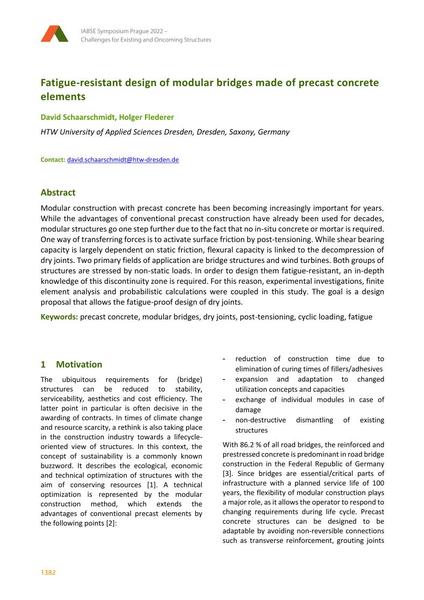Fatigue-resistant design of modular bridges made of precast concrete elements

|
|
|||||||||||
Bibliographic Details
| Author(s): |
David Schaarschmidt
(HTW University of Applied Sciences Dresden, Dresden, Saxony, Germany)
Holger Flederer (HTW University of Applied Sciences Dresden, Dresden, Saxony, Germany) |
||||
|---|---|---|---|---|---|
| Medium: | conference paper | ||||
| Language(s): | English | ||||
| Conference: | IABSE Symposium: Challenges for Existing and Oncoming Structures, Prague, Czech Republic, 25-27 May 2022 | ||||
| Published in: | IABSE Symposium Prague 2022 | ||||
|
|||||
| Page(s): | 1382-1389 | ||||
| Total no. of pages: | 8 | ||||
| DOI: | 10.2749/prague.2022.1382 | ||||
| Abstract: |
Modular construction with precast concrete has been becoming increasingly important for years. While the advantages of conventional precast construction have already been used for decades, modular structures go one step further due to the fact that no in-situ concrete or mortar is required. One way of transferring forces is to activate surface friction by post-tensioning. While shear bearing capacity is largely dependent on static friction, flexural capacity is linked to the decompression of dry joints. Two primary fields of application are bridge structures and wind turbines. Both groups of structures are stressed by non-static loads. In order to design them fatigue-resistant, an in-depth knowledge of this discontinuity zone is required. For this reason, experimental investigations, finite element analysis and probabilistic calculations were coupled in this study. The goal is a design proposal that allows the fatigue-proof design of dry joints. |
||||
| Keywords: |
fatigue cyclic loading precast concrete post-tensioning modular bridges dry joints
|
||||
| Copyright: | © 2022 International Association for Bridge and Structural Engineering (IABSE) | ||||
| License: | This creative work is copyrighted material and may not be used without explicit approval by the author and/or copyright owner. |
||||
